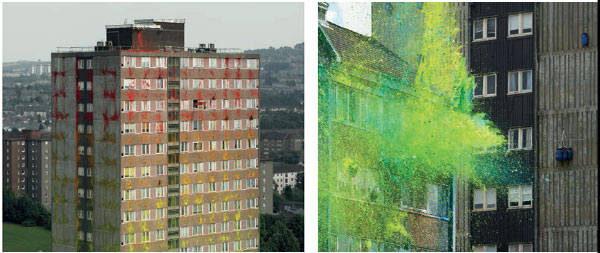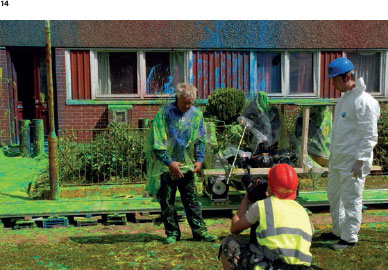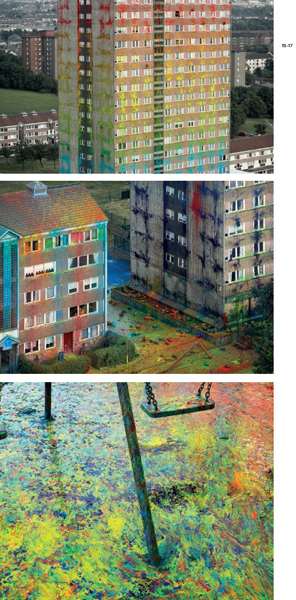Sony Bravia
Paint
Fallon
Following up a successful piece of work, whether it be an album or a piece of great advertising, is never easy. Yet this was the situation that the London-based Fallon advertising agency faced when they began work on Sony Paint, which was the second ad in the Colour Like No Other series of ads for Sony Bravia. The spot followed Balls (see page 172), an ad that startled both the public and the ad industry, and began a trend for warm, folksy ads that continues to this day. Fallon knew that they needed to do something different with the second ad, to create something new that would prove as striking as Balls.

01-03 The Sony Paint ad was filmed using a condemned tower block in Glasgow. The production team look on as hundreds of barrels of paint are detonated up the building to achieve the ‘rainbow sequence’ that is at the core of the film.
‘We shot nothing else that day – nine hours of preparation under dark storm clouds, and four seconds of shooting in about ten seconds of sun at six in the evening. And not a single barrel failed to detonate. Perfect.’
’I think everyone was saying, “you’ve got to do another one now, are you scared?”’ remembers Richard Flintham, then executive creative director at the agency. ‘You shouldn’t be scared – you’ve got a really good company who’s sponsoring you to think of something else that no-one’s seen before. It’s a great thing. It wasn’t the second album, it was the second single, it was fun still.’
The agency came up with the idea of doing a ‘daytime fireworks display’, and quickly brought in director Jonathan Glazer, who helped refine the idea. ‘I’m trying to work out what was on the table before Jonathan was in the room,’ says Flintham. ‘I think there was an idea around a building spewing colour, and there were loads of fire engines squirting different coloured paints to put out the colours. We talked to Jonathan about it, and he quite rightly said that it was trying a little bit too hard.
Although the ball thing felt quite free, we wanted it to feel a bit more constructed; within something like that you’d have to manufacture every stage of it. There would be very little room for God, if you know what I mean. We were trying to explain to Jonathan that it wanted to feel like a daytime fireworks display, and then he said “let’s do that then. Let’s forget the fire engines, let’s just turn it into the most amazing daytime paint fireworks display.” Which is great, that chopped away so much stuff we didn’t need.’
After the sunny San Francisco setting of Balls, the team decided to film Paint in the somewhat more sombre environs of an estate in Glasgow, Scotland. They received permission to film on a condemned tower block that was due to be pulled down in the Toryglen district of the city, and testing began. ‘There were so many obstacles,’ says Glazer. ‘Paint is heavy. Mimicking a fireworks display with gallons of paint instead of grams of gunpowder was incredibly challenging. We spent months and months testing ways to get the paint 22 storeys high. Obviously, because of the paint left on every surface, we had to shoot chronologically and there was no opportunity for a second take on anything, so the planning had to be absolutely meticulous. Nevertheless, with miles and miles of wiring, exactly timed explosives and thousands of barrels filled with very precise shades of colour – filled by an army of art students – it was remarkable that actually everything, apart from the weather, did go to plan.’
According to Glazer, the fireworks were constructed using ‘vast quantities of paint – coloured food thickener that wouldn’t mix to brown or poison the water table; substantial quantities of explosive from black power charges to TNT; and truly heroic amounts of ingenuity, passion and problemsolving from Mark Mason at Asylum [post house] and Chris Oddy, the art director.’
‘The rainbow sequence up the height of the building relied on hundreds of barrels of paint suspended and wired to detonate precisely in time to the music track,’ he continues. ‘The whole sequence was one shot lasting 4.5 seconds, all achieved in camera. For the airborne explosions we basically rigged the sky using cranes that needed cranes to build them, and each of the enormous ground-shaking paint eruptions on the lawn was a one-tonne container full of paint buried and rigged with TNT.’
Alongside heckles from the onlooking locals, the major issue that the team faced on the shoot was the weather, and a stubborn lack of sun. This made for a nerve-racking time for all, as they sat waiting for a section of sunshine to break through in order to capture the rainbow sequence, a shot that could only be done once. ‘I remember sitting there and going “that’s our budget”,’ says Flintham. ‘We could recreate all the other ones. But that’s taken days and days to rig. You’ve got a grey sky, and you don’t really want greyness. It’s fine to have a grey backdrop, but we wanted lightness to hit the colour of the paint, because it would have been a flat colour otherwise.’
The team were only blessed with a tiny window of sunshine to capture the rainbow moment, but achieved it, with Glazer now remembering it as his favourite part of the shoot. ‘It was just such a fantastic four seconds to witness after all the months of work,’ he says, ‘and such a perfect distillation of everything the ad was about. We shot nothing else that day – nine hours of preparation under dark storm clouds, and four seconds of shooting in about ten seconds of sun at six in the evening. And not a single barrel failed to detonate. Perfect.’
Much of the post-production for the ad revolved around removing the cranes and other structures used to set the fireworks from the shot. What is left is the magical sight of paint exploding magnificently up the grey tower block. In the first version of the ad, the team chose to enhance the sense of the triumphant by setting the imagery to the overture to The Thieving Magpie by Gioachino Rossini. A later version uses just the sounds of the paint explosions themselves – which in many ways is more powerful, due to its simplicity. As with Balls, where a frog is unexpectedly shown leaping across one shot, Paint has its own quirky moment, introduced by Glazer. In a surreal scene, a clown is shown running across the frame, giving the film a narrative twist – was he the one who set the explosions?
Due to the success of Balls, there was already much anticipation surrounding Paint before it came out in 2006. Fallon decided to capitalize on this to generate more PR for the ad. The team learnt from the experience on Balls, where onlookers at the shoot shared photos and films of the event online, and realized that giving the audience a taste of what was to come could prove an advantageous strategy. ‘By the time we were doing Paint, we’d had a million views of the making-of film of Balls, not just the commercial, so we built a micro-site [to build interest around the new ad],’ says Laurence Green, then chairman at Fallon.
‘All we said was that we’d upload details of the shoot and early edits… so people did know where it was, and were checking on the site to see what had been uploaded.’ This proved successful, for by the time the ad came out, the media and the public were desperate to see the results. The awkward second album (or single, according to Flintham) more than lived up to expectation, and was eagerly shared, written about and discussed all over the world.
04-05 A hard-hat souvenir from the shoot; Director Jonathan Glazer (left) discusses progress on set with members of the production team.

06-07 The buildings on the estate covered with barrels of paint prior to detonation; cranes were used to put all the paint barrels in place.

08-15 Stills from a short computergenerated film that Jonathan Glazer created to help plan how the ad was shot.

16 The mysterious clown, who appears towards the end of the spot, on set.
‘There was an idea around a building spewing colour, and there were loads of fire engines squirting different coloured paints to put out the colours. We talked to Jonathan about it, and he quite rightly said that it was trying a little bit too hard.’

13-14 The crew attempt to protect themselves and the cameras against the showers of paint.
15-17 The aftermath of the shoot shows the rainbow-coloured paint that covered the buildings and the park in the Toryglen estate, which was demolished as planned after the filming.
‘We spent months and months testing ways to get the paint 22 storeys high. Obviously, because of the paint left on every surface, we had to shoot chronologically and there was no opportunity for a second take on anything, so the planning had to be absolutely meticulous.’





